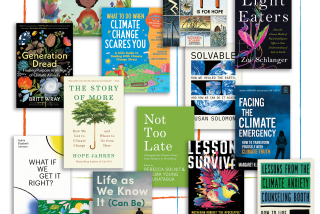Opinion: As a birder, I see the effects of climate change every day. Now, Audubon has quantified the threat
- Share via
For serious birders who regularly observe birds in the wild, ignoring climate change isn’t possible. We have been seeing and documenting the effects of a warming climate since at least the 1950s.
In recent decades, that has meant a consistent northward shift in where species are found. Glossy black great-tailed grackles, previously found primarily in the tropics, first reached southeastern California in 1964; they now stalk and squawk around lowland ponds throughout most of the state. Big tropical seabirds named boobies (because early sailors took their tameness for stupidity) rarely appeared in California’s coastal waters before the 1990s. Now we see dozens offshore from San Diego to the Channel Islands, with some as far north as San Francisco; a few have reached Alaska.
Similar patterns are playing out across the continent as scores of species redraw their range maps, appearing in new areas farther north and vanishing from sites farther south. And the pace is accelerating.
New research from the National Audubon Society released on Thursday highlights the dangers of the trend. For its new report, “Survival by Degrees,” Audubon scientists analyzed the current geographic ranges of 604 North American bird species, and modeled how those ranges would change at different levels of warming.
At a global temperature rise of three degrees Celsius, they found that 389 of those species — or nearly two-thirds of those studied — would become endangered, losing much of their current habitat. Even if some could shift their range northward, they would soon start to run out of room on the map.
Ironically, the changes will make birding more exciting for a while, with birders finding new species in unexpected places, but the downside will be brutal. If warming continues unchecked, Audubon’s models show, many birds will lose massive amounts of territory.
Majestic great gray owls will vanish from Yosemite and the Sierra Nevada range, and from most of Canada as well. Flashy yellow-billed magpies, living nowhere in the world but California’s central valleys, will face almost certain extinction. Even in the greater Los Angeles region, climate change will challenge many of the most familiar birds, including California quail, hummingbirds and the noisy scrub jays so common in suburban back yards. The net loss in numbers and variety could be staggering.
Why does this matter to anyone who’s not a bird watcher?
For one thing, birds fill a crucial niche in the ecosystem, keeping down insect populations and serving as food themselves for larger predators. But they also serve as a visible symbol of broader environmental shifts. It may seem like a cliché to mention the canary in the coal mine, warning miners of dangerous conditions. But bird populations are in many ways the canaries for all of us, and their shifting ranges warn of increasing droughts, floods, fires, desiccating heat, rising seas, untillable farms and unlivable cities.
We still have time to do something about it, however. The potential loss of 389 North American species projected in the Audubon study is what would happen if global readings go up by 3 degrees. But the scientists also modeled what would happen at lesser levels of warming, and the results are striking. Limiting warming to 1.5 degrees would reduce the danger for three-quarters of those threatened birds, Audubon’s modeling found. The obvious canary-in-the-mine message is that this would also be of huge benefit to humans, reducing the potential suffering for people worldwide.
Audubon’s “Survival by Degrees” is not a gloomy forecast but rather a call to action. Audubon is working on ways to help bird species survive the climate change already underway. But the report also stresses the need for action at every level, by individuals and governments alike, to reduce greenhouse gas emissions. Audubon cares about preserving the diversity of bird species, and that is the focus of its new report. But every action to help birds pull through will also make entire ecosystems more resilient.
As a lifelong birder, I’m proud of the role my tribe has played in documenting the effects of climate change. When local conditions change, particular types of frogs or wildflowers may decrease and disappear unheeded. A new moth may colonize a region, and unless it’s an agricultural pest, few will notice. But when a bird species disappears from the local fauna, or a new one arrives, legions of dedicated birders document the change.
Birdwatching is a nonpartisan activity, which means I have friends across the political spectrum. In an era of polarization and partisanship, the love of birds brings us together. I hope we can heed the urgent message in this new report and work together for solutions. Birds tell us we don’t have time to wait.
Author and zealous birder Kenn Kaufman is a field editor for Audubon Magazine.
More to Read
A cure for the common opinion
Get thought-provoking perspectives with our weekly newsletter.
You may occasionally receive promotional content from the Los Angeles Times.










